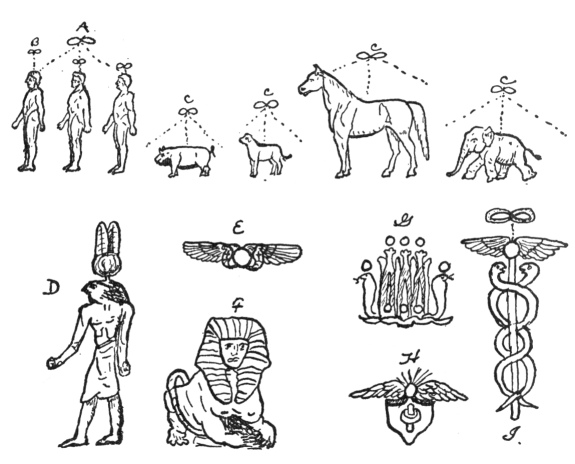
[back]

THE HIGH SELF AND
THE GROUP SOUL. ALSO ANCIENT SYMBOLS RELATED TO HUNA BELIEFS
A. Above three human figures appear three symbols of the High Self, one for each
man. But, above this appears a single symbol for a High Self and from it a
dotted line goes to each man. This latter High Self pictures the probable
doctrine of Huna assigning a "group soul" High Self to the care and direction of
the bodily processes of a related group of people. This High Self lays down the
pattern of growth and directs in some mysterious way all the intricate bodily
processes which, patently, are too complicated for the low self to understand
and direct.
B. The High Self assigned to each person (or perhaps male-female pair) is indicated by the symbol of "eternal progress" over each man in the drawing individually. This High Self makes instant changes in the body of the man, upon proper request, and is able to influence the High Self of a less evolved order acting as the "group soul."
C. All animals, birds, insects, fish, etc., are supposed to have High Self "group souls" guiding them, just as the physical body and low self of man has similar guidance. The dotted lines extending from the symbols of the High Selves (C) indicate by their plurality the fact that each overlooks a number of creatures.
D. The High Selves acting as "group souls" (as materialized by Stewart's teacher in Africa when she used her Huna powers to act on the High Self of the local birds and cause them to gather in a great mixed flock on a hill傭ecoming visible with a vague bird head on a nebulous human body floating in the air) have been pictured as part human, and may have a beast head as in D, taken from a photo of Egyptian images on an ancient temple wall (the god Hathor's temple). The two feathers above the globe over the head of the hawk man suggests a representation of the dual High Self as the secret doctrine behind the exoteric feather symbol.
E. The symbology of ancient Egypt furnishes an excellent design to represent a prayer taking its flight to the High Self. It is indicated in the winged globe. The two serpents may represent the positive and negative in the basic flow of vital force. Or, the low and middle voltage of vital force, both of which are involved in making and sending the prayer thought forms, may be indicated by having two serpents.
F. The Sphinx may be a symbol related to the one of the hawk man (D), but reversed to give the head of a human and the body of a beast.
G. An Egyptian design in which the two serpents appear in connection with symbols of flower buds and small globes set forth to stress the idea of triplicity, perhaps pointing to the ancient Huna belief in three selves, three shadowy bodies, and three vital forces. The waved base for the design is strongly reminiscent of the Huna wave symbol for vital force.
H. This ancient symbol presents the winged thought form with the symbol of human force in union of the sexes. Because of the loss of clear and workable knowledge of the three voltages of human vital force, priests of several ancient religions guessed that the creative force used in procreation had something basic to do with praying effectively to the "gods." This seems not to be the correct assumption as the kahunas, whether male or female, worked their magic regardless of the use of vital force in sex. However, there was a Huna belief that the High Self of a man was composed of a male-female pair.
I. The familiar symbol of the winged staff and its two entwining serpents often embodies the winged globe as a part of its symbology. If the symbol of the High Self were placed over the staff, as in the sketch, the symbol would be fairly complete from a Huna point of view. It is interesting to note the fact that there were no snakes in Polynesia, and that snakes were not used as a symbol of vital force by the kahunas in their verbal descriptives of the mechanisms of their psycho-religious system of magic. It is to be assumed that they never used the serpent symbol or that they lost it after leaving the region of Egypt and living for some centuries in Polynesia. Probably, the use of the serpent came from non-Huna sources, for the kahunas had no word for "snake," although they had one for lizard-like creatures.